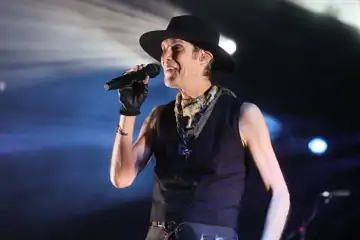When asked where he is right now, Samuel Tetreault (Les 7 doigts de la co-founder/artistic director/performer) replies, "I am in Montreal right now in my training studio, stretching".
Now that he's aged "in the late 30s", Tetreault chuckles, "the body shows some sign of - tiredness, let's say". "If you wanna still do it then it's a matter of training more intelligently, I think. And, for sure — maintaining shape I realised is the most important thing, 'cause your brain and your muscle memory, they know how to do things, but if you're not exactly fit then that's when you get injured."
"We've always been creating circus that involves dancing and movement research, but never to that point where the idea was to really venture into the world of some other choreographer's creative universe."
As well as performing in all three pieces of the Triptyque triple bill that the company are bringing to Melbourne Festival (Australian exclusive), Tetreault is one of the seven co-founders of Les 7 doigts de la main (translation: The Seven Fingers Of The Hand). And he acknowledges Triptyque is "pretty different to everything we have done before". "We've always been creating circus that involves dancing and movement research, but never to that point where the idea was to really venture into the world of some other choreographer's creative universe," he elaborates on inviting three outside choreographers into the studio to create Triptyque.
"The first piece is a duo between me and a dancer who was not a circus performer to begin with, and that's been choreographed by Marie Chouinard," Tetreault informs, of Anne & Samuel. The three pieces are tied together by an overall theme: gravity, which Tetreault identifies is "a force that pulls us downwards... that is essential to any of the circus disciplines, but then it's so essential to the art of dancing".
Before working with Tetreault and the other dancer Anne & Samuel was created on, Chouinard wished to see some videos of the pair improvising and, according to Tetreault, crutches were then introduced as a means for "altering the way that the human body can work".
"I also wanted the whole Triptyque to be a sort of progression," Tetreault shares, from Anne & Samuel (which is "more rooted to the contemporary") to gradually incorporating "a wider variety of circus disciplines" throughout the other two pieces. Although the middle piece - Variations 9.81 ("a quintet of five hand balancers choreographed by Victor Quijada") — incorporates "a lot of choreographic work", Tetreault reveals, "It's still very acrobatic and it's only circus performers that could perform that piece". "And then the third piece, Nocturne, is more anchored in the circus world," he tells of Marcos Morau's work. "For the first time, in the third piece, there's an aerial element. So that's kind of a final progression in the investigation of gravity where you can eventually emancipate yourself and fly and be suspended and, yeah! Levitate," he enthuses.
Triptyque audience members who feel more at home watching contemporary dance will be taken into “the universe that they're not so used to” once circus elements are introduced, Tetreault promises. “And same with the circus audience."















